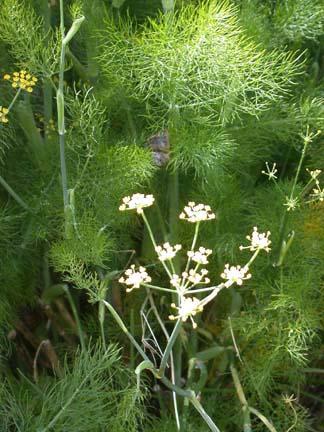|
April 29, 2004
Parsley, sage, rosemary and thyme (and more)by AMY STEWART
MOST PEOPLE THINK OF AN HERB
GARDEN AS A LITTLE square patch near the back door where you
plant parsley, sage, rosemary and thyme. A friend of mine used
to make a dish with those four herbs that he called Chicken Garfunkel;
orderly little gardens planted with ordinary little herbs remind
me of that. Gardens Garfunkel. There's nothing wrong with it
-- it's just a little limited, that's all. My parsley has jumped out of its confinement and seeded all over the perennial border, where its lacy flowers will fill in the gaps later this summer. The culinary sage is the best border plant I've got this time of year, sporting stunning blue spikes of flowers while everything else is just getting going. Rosemary is the backbone of the garden, lending structure and architecture and, later in the summer, attracting bees with its tiny blue flowers. And as for the thyme? I planted lime thyme (Thymus citriodorus) along my garden paths years ago and I've never looked back. In another year or two, they will have grown all the way into the path and I'll walk on a carpet of the fragrant, lemony herb. So this spring, when the nurseries are brimming with unusual and interesting herbs, don't confine them to an herb garden or a planter. Sure, I'm all in favor of planting the essentials near the kitchen door so you can get them quickly, but once you've done that, take a look around at the rose garden, the cut flower border, and even the lawn. Herbs are so versatile that you can use them almost anywhere. [Fennel photo by Amy Stewart] Chives and garlic: Anything in the allium family -- that includes onions, chives, garlic and leeks, as well as ornamental allium grown only for their globe-shaped flowers -- can fit right into an ornamental garden. Organic gardeners are convinced that the strong smell deters pests, especially aphids. Fortunately, the round pink flowers of chives and the dainty purple flowers of society garlic (Tulbaghia amaryllidaceae--not a true allium but garlic-scented nonetheless) look beautiful at the feet of rose bushes, so it's worth giving them a try. Ornamental oregano: There are more than a dozen species of oregano widely grown in this country, but most of us only know Origanum vulgare, sometimes called wild marjoram. If you're going to grow this so that you can cultivate dried herbs, you're probably better off keeping it trimmed back so it doesn't bloom. But there are many other types of oregano that are well worth growing for their blooms. My favorites are O. laevigatum, `Hopley's Purple,' which produces airy, dark purple flowers that dry perfectly and make a great companion to dried feverfew or statice. Another good ornamental oregano to try is O. rotundifolium, `Kent Beauty,' which produces hop-like bracts of pink flowers. Both attract bees like mad and fit into any flower garden. Thyme, thyme, thyme: Believe it or not, thyme is a member of the mint family. It thrives in warm, dry climates, but mine survive the damp winters and cool summers just fine. A more upright, culinary thyme like Thymus vulgaris does well in rock gardens and along rocky walls and paths, where it can soften hard edges and spill into walkways. A creeping thyme or lemon-lime thyme can actually take the place of a lawn or fill in the gaps between flagstones. Pick one whose scent you particularly like, because in the summer, when you walk on the thyme, the scent will be dispersed into the warm air. Dill, fennel and parsley: I group these together because from a design standpoint they accomplish the same goals. They produce feathery foliage, add height to the garden, and offer up lacy sprays of flowers in the summer that work equally well as a filler in the garden or in a bouquet. Common fennel, Foeniculum vulgare, is practically a weed around here, but there are other, better-behaved versions, like the bronze fennel that pairs well with tropical plants, deep reds and dark green or bluish foliage. There's also a lower-growing version called F. azoricum, Florence fennel, grown primarily for its bulb. Dill tends to produce even lighter and airier flowers, but they need more protection from snails and cold, harsh winds. Plant dill in a protected spot (maybe against a sunny wall) or use a plastic bottle with the bottom cut off as a temporary, miniature greenhouse to get help it get established. Parsley -- the flat-leafed variety -- only reaches two or three feet tall, but it re-seeds easily and also produces lovely yellow flowers if you let it bloom. Fortunately, most herbs do better with a minimum of fuss. Lavender and sage, also both members of the mint family, like tough, dry conditions and little or no fertilizer. Herbs can tolerate being trod upon, stuck into rock walls, or squeezed into cracks in broken-up pavement. They appreciate a severe pruning after they bloom and demand little else from you. In fact, once you let them loose in your garden, you may never get them back into that well-behaved plot by the back door again. For more ideas about integrating herbs into the rest of the garden, check out Susan McClure's Culinary Gardens: From Design to Palate, published last year by Fulcrum.
For great deals on herbs and more, check out College of the Redwoods' 14th annual plant sale on Friday, April 30, from noon until 6 p.m. and Saturday, May 1, from 10 a.m. until 6 p.m. at the CR greenhouse. All the plants have been propagated and grown by students as part of their instruction in agriculture classes. Proceeds support the greenhouse and the agriculture program.
garden-related announcements and news to Amy Stewart. IN THE NEWS | COVER STORY | ARTBEAT | THE HUM | PREVIEW | CALENDAR © Copyright 2004, North Coast Journal, Inc. |


